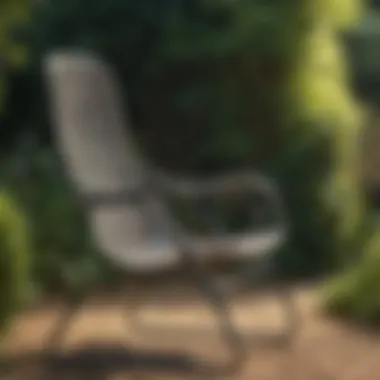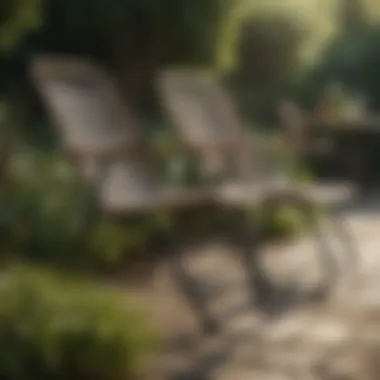Evaluating the Most Comfortable Garden Chair


Intro
Choosing a garden chair may seem like a simple task, yet it can be surprisingly complex. Many factors determine what makes a garden chair truly comfortable. Beyond aesthetic appeal, considerations must include design, materials used, ergonomics, and individual personal preferences. Each of these elements needs to be carefully evaluated to find a chair that not only looks good in your outdoor space but also enhances your comfort during use.
This article aims to provide a thorough exploration of essential elements influencing garden chair comfort. It will evaluate various styles available in the market and help guide you in selecting an ideal chair for your unique needs. Also, the discussion will touch on maintenance tips that ensure longevity and comfort in your outdoor seating. Well-known brands that prioritize comfort while maintaining beautiful designs will also be highlighted. By the end of the reading, you will have a wealth of information to make an informed decision about your next garden chair purchase.
Prolusion to Garden Chairs
Garden chairs play a critical role in enhancing outdoor spaces. They serve not only as functional seating but also as focal points that can complement the beauty of gardens, patios, or balconies. The design and comfort of these chairs directly impact one's outdoor experience. A well-designed garden chair invites relaxation and enjoyment, making it an essential element for homeowners and outdoor enthusiasts alike.
The Role of Comfort in Outdoor Furniture
Comfort is paramount when it comes to outdoor furniture like garden chairs. People tend to spend extended periods outdoors, whether reading a book, hosting friends, or simply enjoying nature. A chair that does not provide adequate support or comfort can lead to discomfort and detract from the overall experience. The right garden chair allows one to unwind, facilitating conversations and moments of peace. It should accommodate the body's natural posture, allowing for extended use without strain.
Historical Perspective of Garden Chairs
The history of garden chairs reflects changing design trends and societal values. Initially, outdoor seating was rudimentary, often made from natural materials like wood or stone. As innovations emerged, so too did the variety and complexity of designs. The Victorian era, for example, saw a rise in ornate garden furniture, often crafted with intricate details. The 20th century brought about a shift toward more functional and ergonomic designs, aligning with modern principles of comfort and usability. Today, garden chairs blend aesthetics with practicality, incorporating diverse materials such as metal, plastic, and fabric. This evolution highlights not only the advancements in furniture design but also the increasing emphasis on comfort and personal preference in outdoor living.
Key Factors Influencing Comfort
When evaluating garden chairs, understanding the key factors influencing comfort is essential. This knowledge allows consumers to make informed decisions based on their personal preferences and needs. Comfortable seating enhances outdoor experiences and promotes relaxation or enjoyment during gatherings. Knowing specific elements that affect comfort helps in selecting the right chair for your situation.
Ergonomic Design Principles
Ergonomic design is crucial in garden chairs. This principle focuses on creating a structure that supports the natural posture of the body. A well-designed chair conforms to the body's curvature, thereby preventing discomfort and fatigue during prolonged use. Features such as an appropriate seat height, armrest placement, and backrest angles contribute significantly. Chairs that allow freedom of movement while providing adequate support are ideal.
Some ergonomic chairs also include adjustments for individual preference, which is a beneficial aspect. Overall, the aim is to enhance user comfort ensuring a better outdoor experience.
Material Selection and Its Impact
Material choice significantly impacts comfort in garden chairs. It affects not just tactile feel but also durability and maintenance needs. Here are some common materials used for garden furniture:
Wood
Wood is a classic choice for garden chairs. Its natural beauty is appealing, and different types of wood offer various characteristics. For example, teak wood is known for its resistance to weathering. This means it can last many years outside if maintained properly. The warm feel of wood also adds to comfort as it does not become too hot in the sun.
However, it requires regular upkeep to protect against moisture and pests.
Metal
Metal chairs often have a sleek and modern look. Aluminum, for instance, is lightweight and resistant to rust. This makes it a practical choice for outdoor use. Metals can sometimes feel cold to the touch, which might detract from comfort initially. Adding cushions can mitigate this. The durability of metal chairs is a strong point, as they generally require less maintenance than wood.
Plastic
Plastic outdoor chairs are highly versatile and often come in a variety of colors. They are lightweight and easily moved around, which is great for gatherings or events. Plastic is resistant to moisture and easy to clean, making it a practical option. However, some may find these chairs less substantial in terms of comfort. The absence of cushioning can make sitting for long periods less enjoyable.
Fabric


Fabric chairs add an element of coziness not found in more rigid materials. Many fabric options for garden use are treated to resist moisture and fading. Cushioned fabric chairs provide additional comfort but require more maintenance. Regular cleaning is needed to keep the fabric looking fresh. They are available in many styles and colors, making them a fashionable choice for outdoor seating. But, if not cared for, they can attract dirt and mildew.
Cushioning and Support
Cushioning plays a critical role in overall comfort. The right amount of padding can make a chair inviting and comfortable for long periods. Support aspects like lumbar support should also be considered. These ensure that the lower back is not strained while sitting. High-backed chairs often provide better support and comfort as well. In choosing cushions, consider material and thickness which can enhance or detract from the overall comfort level of the chair.
Types of Garden Chairs
Understanding the different types of garden chairs is a crucial aspect of selecting a comfortable outdoor seat. This section covers various styles that cater to diverse preferences, environments, and specific uses. Choosing the right type enhances aesthetic appeal and functional satisfaction. Each chair type has its design elements, benefits, and considerations that can make or break your outdoor experience.
Deck Chairs
Deck chairs are designed primarily for lounging. They typically feature a straightforward folding mechanism, allowing for easy transport and storage. Their slatted design often promotes airflow, making them suitable for hot days. Deck chairs also come in various materials such as wood, metal, and weather-resistant fabric. Considerations when selecting a deck chair include portability, weight, and durability. If you plan to move your chair frequently, choose a lightweight option without sacrificing sturdiness.
Adirondack Chairs
Adirondack chairs offer a distinctive, relaxed silhouette. Their wide seat and high back provide ample comfort, especially for extended sitting periods. Known for their charming style, these chairs are often made from durable woods like cedar or from recycled materials. They tend to have a comfortable recline which promotes relaxation. However, their design may not be suited for small spaces due to their larger footprint. When choosing an Adirondack chair, consider where it will be placed and the available space to accommodate its size.
Lounge Chairs
Lounge chairs are synonymous with comfort, embodying a spacious seat and an adjustable reclining feature. They often come with cushions that enhance relaxation, making them ideal for lazy afternoons. Common materials include aluminum and teak, which resist weather conditions. Adjustability is a key factor in their comfort level. Evaluate how easy it is to modify the reclining angle and whether the chair offers the desired level of support. Additionally, consider the overall aesthetic to ensure it aligns with your outdoor decor.
Rocking Chairs
Rocking chairs introduce a soothing motion that promotes relaxation. This classic design suits a variety of settings, from porches to gardens. Made from wood or metal, they often feature comfortable seating. When evaluating rocking chairs, stability is paramount. Ensure the chair’s base is correctly designed to allow for smooth rocking without tipping. Some models come with cushions, enhancing comfort during longer sitting periods. Think about the space you have available, as rocking chairs need room to move.
Foldable Chairs
Foldable chairs are defined by their convenience. These chairs are light, easy to set up and take down, making them suitable for gatherings or events. They often come in portable designs and can be made from various materials. Wood and aluminum are common choices. When considering foldable chairs, evaluate how compact they are when folded. This characteristic is essential if storage space is a concern. Moreover, consider the comfort of the seat and backrest as these can be limiting factors in usability.
In summary, knowing the differences among these types of garden chairs helps you make an informed decision. Each type serves its unique purpose, and understanding their characteristics allows you to choose wisely.
Aesthetic Considerations
Aesthetic considerations play a crucial role in choosing the most comfortable garden chair. While comfort and usability are important, the visual appeal of outdoor chairs cannot be overlooked. A garden chair should enhance the outdoor space rather than detract from it. This section examines color and design trends as well as the importance of blending with outdoor decor.
Color and Design Trends
Current color and design trends significantly influence the selection of garden chairs. Homeowners and designers now prefer hues that reflect nature, such as various shades of green, earth tones, and soft pastels. Metal finishes are gaining popularity as they offer a sleek and modern look. Furthermore, sustainable materials are not just practical but also resonate with the aesthetics of eco-conscious consumers.
When assessing color, it's crucial to consider not only how it looks in isolation but also how it complements existing landscaping and outdoor themes. For instance, a vibrant red chair may become a focal point in a neutral garden, while muted tones may add sophistication without overwhelming the senses.
Blending with Outdoor Decor
To achieve a harmonious garden, the selection of chairs needs to align with the overall outdoor decor. Factors such as style consistency and the arrangement of outdoor elements are important considerations. For instance, a rustic wooden chair can enhance the charm of a cottage garden, while sleek metal chairs might suit contemporary settings.
Consider the entire environment before making a selection. Photographs of the entire outdoor space can help visualize how the chair will appear when placed among plants, tables, and other furniture. Each piece should contribute to a cohesive look. Free-standing chairs, for example, can serve as artistic statements, while those integrated into larger furniture sets create a more unified atmosphere.


A well-chosen chair not only provides comfort but also enhances the beauty of the garden space, merging functionality with aesthetics.
Where to Purchase Comfortable Garden Chairs
Purchasing the right garden chair is a crucial step in ensuring that you maximize your outdoor comfort. Selecting the appropriate seating involves understanding not just the chair's design and functionality but also where to find it. The process of buying a garden chair should take into account several factors, such as accessibility, pricing, and the ability to assess comfort before purchase. A proper purchasing choice will lay a solid foundation for enjoying outdoor activities, making it necessary to explore both physical and online options thoroughly.
Physical Retail Options
Shopping at physical stores has its advantages, especially when choosing a garden chair. You can directly experience the product, assessing comfort, size, and style. Touching different materials also helps in determining which aspect feels right for your needs.
In a brick-and-mortar setting, knowledgeable staff are usually available for assistance, helping to identify features that align with your preferences. Store displays are often set up to showcase various models in a simulated outdoor environment, allowing potential buyers to visualize the product in a realistic context. Moreover, having the ability to compare different models side-by-side can be invaluable when deciding on comfort and aesthetics.
However, potential downsides include a limited selection compared to online retailers. Also, depending on regional availability, certain brands may not be stocked in every store, which narrows choices for consumers. Therefore, while physical retail spots can be beneficial, they should be considered part of the broader strategy for finding the ideal garden chair.
Online Shopping Benefits
Online shopping offers distinct advantages that complement physical store buying. First, it provides a much wider selection of garden chairs from various brands. This ultimately expands your options beyond what is regionally available in stores.
Purchasing online encourages comparative shopping, allowing you to review multiple sellers and pricing in one sitting. Additionally, consumer reviews and ratings serve as valuable tools in assessing a chair's comfort level and overall quality. Many online platforms also facilitate easy returns, making the shopping experience less risky.
Another significant benefit is the convenience. You can browse and purchase chairs at any time, eliminating the need to work around store hours. Some online retailers may even offer home delivery options, which further enhance the convenience of acquiring your garden chairs.
In summary, choosing between physical retail options and online shopping depends on personal preferences and needs. Weighing the pros and cons of each approach can guide you toward making an informed decision. Consider visiting physical stores to test comfort, then explore online options for broader selections and competitive pricing.
Maintenance and Care for Longevity
Maintaining and caring for garden chairs is essential for ensuring their longevity and retaining comfort over time. Garden chairs endure various weather conditions, exposure to dirt, and potential wear from regular use. Proper maintenance not only preserves their aesthetic appeal but also extends their useful life. In addition, regular upkeep can prevent costly repairs or replacements which adds value to any investment in outdoor furniture.
Investing time in maintenance enhances the overall outdoor experience. Clean and well-maintained chairs provide a welcoming environment for gatherings and relaxation. Moreover, understanding the specific needs for different materials, such as wood, metal, or fabric, can lead to better preservation practices.
Cleaning Techniques
Cleaning garden chairs should be an integral part of care routines. Here are several effective techniques depending on the material:
- Wood: Use a soft brush or cloth to remove dust. For deeper cleaning, a mix of mild soap and water works well. Avoid soaking wooden chairs, and make sure to dry them thoroughly.
- Metal: Wipe with a damp cloth to remove debris. For rust, apply a rust remover or mild abrasive, followed by a protective coat of wax or oil.
- Plastic: Use soapy water and a sponge to clean plastic chairs, as they are easy to maintain. Avoid harsh chemicals that might scratch or dull the surface.
- Fabric: Always check care labels. For outdoor upholstery, spot clean with a mild detergent and water. Regular vacuuming can also help eliminate dirt and dust.
These practices not only enhance cleanliness but also contribute to the longevity of your garden chairs.
Seasonal Storage Practices
The changing seasons can significantly affect garden chairs, so it's crucial to adopt appropriate storage practices throughout the year. Proper storage protects chairs from elements like rain, snow, or intense sun, which can cause damage over time. Here are practical tips:
- Winter Storage: Ideally, store chairs indoors in a dry environment. If indoor storage isn't possible, cover them with waterproof covers. Securely tie any coverings to prevent wind loss.
- Summer Precautions: During the hottest months, consider positioning chairs in shaded areas to protect against UV rays. Regularly check for any signs of wear or fading.
- Spring and Fall Maintenance: Clean chairs thoroughly at the start of spring and autumn to remove accumulated debris. Inspect for damages and repair them promptly to avoid further complications.
Brands to Consider
When selecting a garden chair, the brand holds significant weight in the decision-making process. Various brands bring unique strengths to the table, and understanding these can greatly influence your experience and satisfaction. In the world of outdoor furniture, reputable brands often invest in quality, design, and comfort. This commitment assures customers that they are making a sound investment rather than merely purchasing a seat.


Key Considerations for Choosing Brands:
- Quality Assurance: Reputable brands often maintain higher standards in materials and construction. Looking for trusted names can lead you to genuinely comfortable and long-lasting garden chairs.
- Design Innovations: Premium and value brands alike frequently introduce innovative designs. Whether it's ergonomic shapes or weather-resistant materials, these features often enhance overall comfort.
- Warranty and Customer Support: Established brands usually provide warranties and responsive customer service. This can be essential in case of any issues down the line, ensuring peace of mind with your purchase.
"Selecting the right brand can mean the difference between a fleeting outdoor experience and one that enhances your time outside."
Premium Brands
Some brands excel in the premium category, offering luxury garden chairs that prioritize comfort and quality.
- Herman Miller: Known for timeless design and ergonomic principles, this brand offers outdoor chairs that redefine comfort. Their products often feature natural materials like wood and aluminum, accommodating various aesthetics while ensuring durability.
- Gloster: A leader in high-end outdoor furniture, Gloster combines craftsmanship with style. Their garden chairs showcase beautiful details and contemporary designs, making each chair not just a seat but also a statement piece for your garden.
- Dedon: Utilizing innovative synthetic fibers, Dedon provides beautifully crafted chairs that withstand the elements. Their designs blur the line between indoor and outdoor furniture, offering a unique sense of modern luxury.
These brands are ideal for homeowners who value not only comfort but also the remarkable aesthetic enhancement of their outdoor spaces.
Value Brands
Conversely, some brands focus on delivering quality at a more accessible price point. These value brands can often provide excellent comfort and design without breaking the bank.
- IKEA: While known primarily for indoor furniture, IKEA offers a variety of outdoor seating options. Their chairs combine modern design with functionality, appealing to budget-conscious consumers.
- Mainstays: Often found in Walmart, Mainstays provides a solid selection of affordable garden chairs. The brand focuses on ease of use and practicality, making outdoor seating enjoyable without a hefty investment.
- Home Depot Brand Products: Home Depot allows access to various value brands, offering garden chairs that are both functional and comfortable. Their options are typically made from durable materials, ensuring longevity and comfort in outdoor settings.
Choosing the right brand can ensure that you enjoy your garden chair for years to come, helping to create an inviting outdoor area.
User Testimonials and Reviews
User testimonials and reviews play a critical role in the process of selecting the most comfortable garden chair. They offer real-life perspectives from actual users that provide insight into how well a chair meets various comfort criteria over time. When evaluating garden chairs, it is not only the product specifications that matter but also how they perform in practical, everyday situations. Testimonials can make the abstract concepts of comfort, ergonomics, and functionality tangible.
One significant benefit of user reviews is the breadth of experiences they encompass. Different individuals have unique preferences regarding comfort and usability, influenced by factors such as body type, personal taste, and intended use of the chair. For instance, a chair that provides exceptional comfort for a tall person may not yield the same result for someone shorter. Reading multiple testimonials helps potential buyers gauge how well a particular model may suit their own needs.
Furthermore, reviews may highlight specific features that impact comfort but are not always evident in product descriptions. Users may express their delight or disappointment over aspects such as cushioning firmness, armrest height, or back support that contribute significantly to overall satisfaction. It’s not uncommon for reviews to reference how often cushions need replacing or how easy it is to maintain the fabric, thus influencing the longevity of comfort.
In addition to opinions on comfort, reviews often discuss durability and build quality. A comfortable chair is of little value if it cannot withstand regular outdoor use. Customers usually share how their chairs fair against weather elements, wear and tear, and the maintenance required to keep them in good condition.
Thus, the weight of user testimonials lies in their authentic stories and critiques. They provide an avenue for potential buyers to assess comfort levels beyond specifications and design. As such, the insights shared by other users serve as valuable information, equipping readers not merely with a list of features but with a detailed assessment of how a garden chair holds up in real-world scenarios.
"Actual user reviews often highlight features that impact comfort but are not always evident in product descriptions."
Case Studies of Popular Models
Examining case studies of popular models can further enhance understanding of comfort in garden chairs. Here are several noteworthy examples that illustrate how different designs cater to various comfort needs:
- Adirondack Chair - Users frequently praise these chairs for their wide armrests and high back support. Many testimonials mention how the sloped seat provides excellent comfort for prolonged lounging sessions.
- Zero Gravity Chairs - These chairs are highlighted in user reviews for their unique ability to reduce pressure on the body by distributing weight evenly. Many customers report significant relief from lumbar pain when using these chairs for extended periods.
- Rocking Chairs - Users enjoy the motion these chairs provide. Reviews often mention how the gentle rocking can be soothing, especially for individuals seeking relaxation outdoors.
- Foldable Chairs - Perfect for those who prioritize convenience, reviews often emphasize lightweight design and ease of storage. However, comfort expectations can vary depending on the materials used.
Ending
In this article, we have explored various aspects of choosing the most comfortable garden chair, considering how different factors influence comfort, style, and usability. Understanding these elements is crucial for homeowners, design enthusiasts, and anyone who values time spent outdoors.
Summarizing Key Points
- The Importance of Comfort: Comfort effects how one experiences outdoor spaces. A well-designed garden chair can enhance relaxation and social interactions.
- Key Factors: Ergonomics, material selection, and cushioning are vital components. Ergonomics ensures support for the body, while materials can dictate durability and aesthetics.
- Types of Chairs: Knowing the different styles, from Adirondack to foldable chairs, helps tailor choices to specific outdoor settings and activities.
- Maintenance Matters: Caring for your garden chair can extend its life and keep it looking good. Regular cleaning and proper seasonal storage are essential strategies.
- Brands and Buying Options: There are premium and value brands that cater to various tastes and budgets. Whether shopping in stores or online, understanding the offerings can lead to better decisions.
"Selecting the right garden chair is not just about aesthetics; it's also about comfort and functionality in outdoor living."
Final Recommendations
- Test Before You Buy: Sit in different models to gauge comfort. Each person's needs can vary widely.
- Think Long-Term: Select materials that can withstand weather conditions specific to your area. For instance, teak and aluminum often offer solid longevity against elements.
- Prioritize Ergonomics: Look for designs that support your posture well. Comfort should always be paramount.
- Consider Aesthetics: Ensure the chair complements your garden's layout and decor. It should not only serve as a seating solution but add to the beauty of the space.



